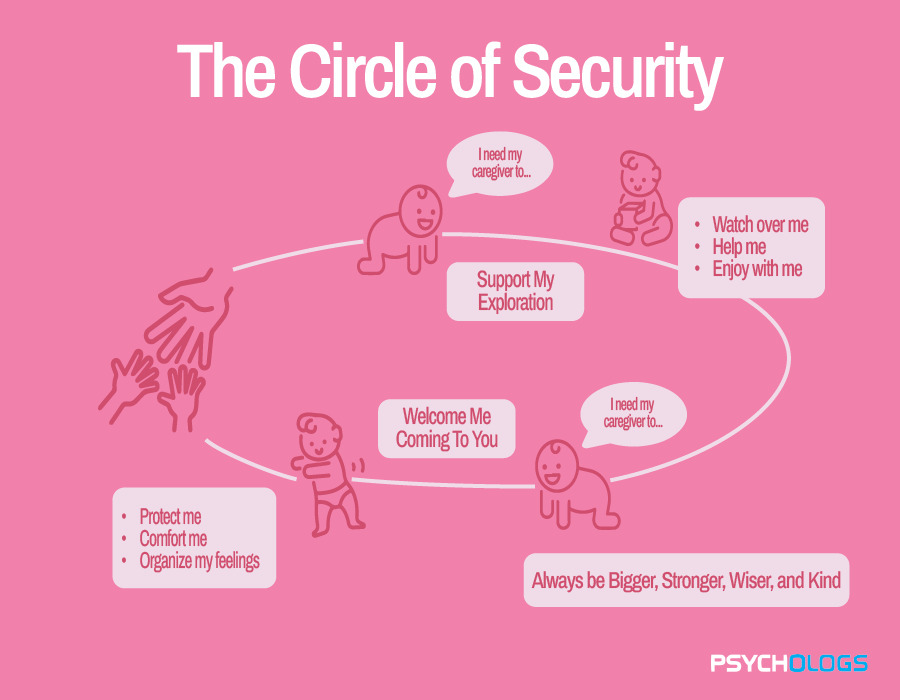Human beings are hardwired for connection. From infancy onward, we seek relationships that impart a sense of safety, value, and understanding. Central to this theory is attachment, pioneered in the mid-20th century by the British psychoanalyst John Bowlby. Bowlby’s work on attachment laid the foundation for what was to evolve into the Circle of Security- one of the most highly regarded models to support caregivers in nurturing secure relationships with their children.
Though originally based on Bowlby’s observations and later expanded upon by Mary Ainsworth and others, the Circle of Security is much more than just a theory. It is, in fact, a practical tool, giving parents and caregivers a visual map of the child’s needs and directions about meeting those needs in ways that foster emotional security, resilience, and healthy development.
The Roots of the Circle of Security in Attachment Theory
According to John Bowlby’s attachment theory, the infant is born with an inherent craving to create an emotional link with one or more caregivers, which is crucial for survival. Early bonds involve more than just physical intimacy; they are essential in providing a secure foundation from which a kid can venture out to experience the world and return for solace in times of need.
Bowlby describes how the early nature of the attachments determines the expectations of relationships throughout life for the child. Early caregivers who consistently meet a child’s physical and emotional requirements help the child build self-confidence and an expectation that people will be trustworthy. A kid may develop patterns of insecure attachment when caregivers fail to respond to their needs consistently or are inaccessible to them. This can lead to the child having trouble controlling their emotions and building relationships.
The Circle of Security was designed to bring these insights into everyday parenting. Developed by clinical psychologists Kent Hoffman, Glen Cooper, and Bert Powell, the Circle of Security takes Bowlby and Ainsworth’s theories and translates them into a simple, compassionate model that caregivers can apply in real life.
Understanding The Circle of Security
At its very basic, the circle of security describes the continual oscillation between two basic child needs:
- To explore the world
- To seek comfort and protection
Imagine a circle. At the lower end, the caregiver forms a secure base and haven. The child at the very top symbolises the child’s world exploration. As a child plays, learns, and interacts with the world, he or she moves away from the caregiver. The child then comes back down to the base of the circle whenever he or she feels overwhelmed, scared, tired, or in dire need of reassurance, to seek comfort and mental renewal to restore a sense of security.
During this dynamic, a caregiver is to be with the child in their journey outward as well as back toward the base. The model affirms what is currently referred to as following the child’s need, supporting exploration while being emotionally available and responsive when the child seeks connection.
The Key Elements of the Circle of Security


The Circle of Security points out some important caregiving tasks:
- Supporting exploration: Children need caregivers who encourage their curiosity, celebrate their achievements, and provide an environment where they can safely take risks. The caregiver is a secure base to refer to, watching and delighting in the child’s exploration and offering help when needed.
- Welcome Return: There are times when children come back for comfort and need adults who can welcome them with warmth and empathy, protect them, soothe them, and help them make sense of their feelings.
- Bigger, stronger, smarter, and kinder: Caregivers are reminded by this Circle of Security statement that they are the leaders of the relationship and must be both sympathetic and helpful while also giving guidance.
- Repairing ruptures: No parent or caregiving adult is perfect. In the Circle of Security, they acknowledge that sometimes mistakes do happen. What really matters is whether the caregiver is willing to notice, pause, reflect, and work on restoring the relationship after interruption in emotional attunement has occurred.
- Shark music and self-awareness: The model also helps caregivers become cognizant of their emotional triggers (also named as “shark music” in model language), interfering with responding to their child’s needs. By boosting self-awareness, caregivers can turn out to be more effective and other-oriented in their responses.
Importance of Secure Attachment
Children who grow up with a stable attachment style typically have better self-esteem, better emotional control, and a unique way of interacting with others. They, in general, tend to be more able to face the challenges life presents them with and are more confident. They are also more confident to venture into the unknown or take risks when the opportunity presents itself.
This is not a promise to guarantee the perfection of parenting techniques. Rather, the model is a map of good enough parenting: the child will be provided for far enough, curing the child of the inner doubt about being safe and connected. Giving the child the tools needed to deal with emotional discomfort is better than protecting the child from ever having to face such situations, whereas, without these tools, children can remain distressed and vulnerable.
Circle of Security in Practice
Many caregivers find this model in the Circle of Security such an empowering one because it distils abstract ideas about attachment into practical guidance. Parenting is hard, even emotionally demanding; however, the Circle gives assurance to caregivers that it is not their infallible reactions that matter, but that they exist and are sensitive to the child. The Circle of Security programs have been applied worldwide in home-based, preschool, and community-based settings to reinforce relationships with caregivers of infants, toddlers, and older children.
The uniqueness of the Circle of Security lies in its being a non-prescriptive list of dos and don’ts. Instead, the program allows the caregiver to contemplate the nature of their relationship with the child, identify patterns therein, and gently move into greater emotional attunement. This kind of reflection nurtures empathy, patience, and a deeper connection that, in turn, benefits both the child and the caregiver.
Conclusion
The Circle of Security provides a kind and straightforward way to view and support children with attachment needs. Founded by the pioneer of attachment theory, John Bowlby, secure attachment does not necessarily mean doing everything perfectly, but about being fully present, responsive, and willing to repair and reconnect when things go wrong.
Following the child’s needs for exploration and comfort and being conscious of our emotional responses as caregivers, would begin a loose foundation for emotionally healthy, confident, and connected kids. Whether a parent, teacher out working with families, or any other professional, the Circle of Security reminds us that a secure and loving relationship lies at the heart of growth and resilience.
FAQs
1. How can we relate the Circle of Security to John Bowlby’s attachment theory?
The Circle of Security rests upon the foundation of John Bowlby’s attachment theory, which lays emphasis on early emotional bonds between the child and caregivers. The model translates Bowlby’s views into practical parenting: how caregivers can offer a secure base for exploration and the safe haven needed for comfort.
2. What are the basic needs that the Circle of Security identifies in children?
According to the Circle of Security, there are two major needs of a child: to be able to explore the world and to be able to return to an adult for comfort and reassurance. It is by acting upon these needs that a caregiver assists a child in feeling secure and confident
3. What is the caregiver’s role in the Circle of Security?
Inside the Circle of Security, the caregiver stands grounded at the bottom of the circle: an environment full of a secure base from where the child explores with ethos, and a haven to return to, if needed. Caregivers are required to attend emotionally and to support and encourage children to develop both independently and in their need to connect.
4. Can mistakes as a caregiver in using the Circle of Security approach be forgiven?
Yes, The Circle of Security reminds that imperfect caregivers are the best caregivers: just “good enough.” More importantly, it is a willingness to acknowledge when things go wrong, to reflect on those moments, and to try to repair the relationship with the child.
5. What is meant by “shark music” in the Circle of Security model?
“Shark music” refers to a caregiver’s emotional triggers or discomfort that arise when a child’s needs stir unresolved issues within them. Realisation of “shark music” enables the caregiver to react to the child’s needs with calmness and compassion, rather than from anxiety and fear.
Read More from Us
- Bandura’s Social Learning Theory
- Freud’s Stages of Psychosexual Development
- Understanding Behavioural Concerns in Educational Settings
- Autism Spectrum Disorder: Diagnosis, Symptoms, and Management
- Attachment Theory: Understanding Bonds and Their Impact on Development
References +
- MSEd, K. C. (2025b, January 29). What is attachment theory? Verywell Mind. https://www.verywellmind.com/what-is-attachment-theory-2795337
- Julie. (2023, December 4). Attachment: Psychology Definition, History & Examples. Dr. Philip G. Zimbardo. https://www.zimbardo.com/attachment-psychology-definition-history-examples/
- Security, C. O. (2022b, September 15). What is the Circle of Security – Circle of Security International. Circle of Security International. https://www.circleofsecurityinternational.com/circle-of-security-model/what-is-the-circle-of-security
- MSEd, K. C. (2023, September 12). Biography of psychologist John Bowlby. Verywell Mind. https://www.verywellmind.com/john-bowlby-biography-1907-1990-2795514







Leave feedback about this